
The Advanced Gas-cooled Reactor (AGR) is a type of nuclear reactor designed and operated in the United Kingdom. These are the second generation of British gas-cooled reactors, using graphite as the neutron moderator and carbon dioxide as coolant. They have been the backbone of the UK's nuclear power generation fleet since the 1980s.

Torness nuclear power station is a nuclear power station located approximately 30 miles (50 km) east of Edinburgh at Torness Point near Dunbar in East Lothian, Scotland. It was the last of the United Kingdom's second generation nuclear power plants to be commissioned. Construction of this facility began in 1980 for the then South of Scotland Electricity Board (SSEB) and it was commissioned in 1988. It is a local landmark, highly visible from the A1 trunk road and East Coast Main Line railway.
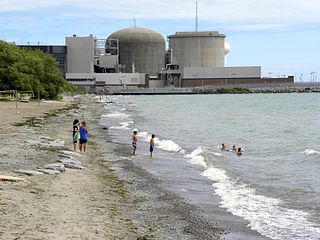
Pickering Nuclear Generating Station is a Canadian nuclear power station located on the north shore of Lake Ontario in Pickering, Ontario. It is one of the oldest nuclear power stations in the world and Canada's third-largest, with eight CANDU reactors. Since 2003, two of these units have been defueled and deactivated. The remaining six produce about 16% of Ontario's power and employ 3,000 workers.
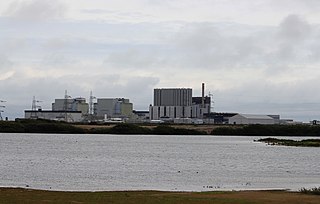
The Dungeness nuclear power stations are a pair of non-operational nuclear power stations located on the Dungeness headland in the south of Kent, England.

Bruce Nuclear Generating Station is a nuclear power station located on the eastern shore of Lake Huron in Ontario, Canada. It occupies 932 ha of land. The facility derives its name from Bruce Township, the local municipality when the plant was constructed, now Kincardine due to amalgamation. With eight CANDU pressurized heavy-water reactors, it was the world's largest fully operational nuclear generating station by total reactor count and the number of currently operational reactors until 2016, when it was exceeded in nameplate capacity by South Korea's Kori Nuclear Power Plant. The station is the largest employer in Bruce County, with over 4000 workers.

The EPR is a third generation pressurised water reactor design. It has been designed and developed mainly by Framatome and Électricité de France (EDF) in France, and by Siemens in Germany. In Europe this reactor design was called European Pressurised Reactor, and the internationalised name was Evolutionary Power Reactor, but is now simply named EPR.

The Calvert Cliffs Nuclear Power Plant (CCNPP) is a nuclear power plant located on the western shore of the Chesapeake Bay near Lusby, Calvert County, Maryland in the Mid-Atlantic United States. It is the only nuclear power plant in the state of Maryland.
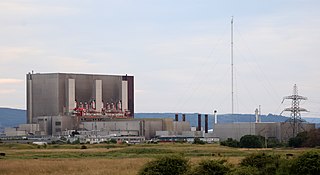
Hartlepool nuclear power station is a nuclear power station situated on the northern bank of the mouth of the River Tees, 2.5 mi south of Hartlepool in County Durham, North East England. The station has a net electrical output of 1,185 megawatts, which is 2% of Great Britain's peak electricity demand of 60 GW. Electricity is produced through the use of two advanced gas-cooled reactors (AGR). Hartlepool was only the third nuclear power station in the United Kingdom to use AGR technology. It was also the first nuclear power station to be built close to a major urban area.

Kaiga Generating Station is a nuclear power generating station situated at Kaiga, near the river Kali, in Uttara Kannada district of Karnataka, India. The plant has been in operation since March 2000 and is operated by the Nuclear Power Corporation of India.

Since the mid 1980s, the largest source of electricity in France has been nuclear power, with a generation of 379.5 TWh in 2019 and a total electricity production of 537.7 TWh. In 2018, the nuclear share was 71.67%, the highest percentage in the world.
Nuclear power in the United Kingdom generated 16.1% of the country's electricity in 2020. As of August 2022, the UK has 9 operational nuclear reactors at five locations, producing 5.9 GWe. It also has nuclear reprocessing plants at Sellafield and the Tails Management Facility (TMF) operated by Urenco in Capenhurst.

EDF Energy is a British integrated energy company, wholly owned by the French state-owned EDF, with operations spanning electricity generation and the sale of natural gas and electricity to homes and businesses throughout the United Kingdom. It employs 11,717 people, and handles 5.22 million business and residential customer accounts.
Nuclear decommissioning is the process leading to the irreversible complete or partial closure of a nuclear facility, usually a nuclear reactor, with the ultimate aim at termination of the operating licence. The process usually runs according to a decommissioning plan, including the whole or partial dismantling and decontamination of the facility, ideally resulting in restoration of the environment up to greenfield status. The decommissioning plan is fulfilled when the approved end state of the facility has been reached.
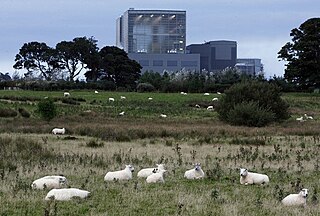
Hunterston B nuclear power station is a shut-down AGR nuclear power station in North Ayrshire, Scotland. Located about 6 miles (9.7 km) south of Largs and about 2.5 miles (4.0 km) northwest of West Kilbride on the Firth of Clyde coast. It is currently operated by EDF Energy, and began producing electricity in 1976.
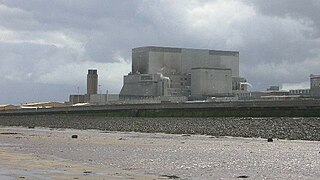
Hinkley Point B nuclear power station was a nuclear power station near Bridgwater, Somerset, on the Bristol Channel coast of south west England. It was the first commercial Advanced Gas Cooled reactor to generate power to the National Grid in 1976 and shares its design with sister station Hunterston B nuclear power station. It ceased operations permanently on 1 August 2022.

The Sizewell nuclear site consists of two nuclear power stations, one of which is still operational, located near the small fishing village of Sizewell in Suffolk, England. Sizewell A, with two Magnox reactors, is now in the process of being decommissioned. Sizewell B has a single pressurised water reactor (PWR) and is the UK's newest nuclear power station. A third power station, to consist of twin EPR reactors, is planned to be built as Sizewell C.

The Chooz Nuclear Power Station lies in the municipality of Chooz in the Ardennes department, France, on the Meuse River in a panhandle protruding into Belgium, between the French city of Charleville-Mézières and the Belgian municipality of Dinant, near the comune of Givet.

The IPHWR-700 is an Indian pressurized heavy-water reactor designed by the NPCIL. It is a Generation III reactor developed from earlier CANDU based 220 MW and 540 MW designs. It can generate 700 MW of electricity. Currently there are 5 units under construction and 10 more units planned, at a cost of ₹1.05 lakh crore (US$13 billion).
This is a list of all the commercial nuclear reactors in the European Union and in Europe, with operational status. The list only includes civilian nuclear power reactors used to generate electricity for a power grid. All commercial nuclear reactors use nuclear fission. As of May 2021, there are 180 operable power reactors in Europe, with a combined electrical capacity of 159.36 GW. There are currently 8 power reactors under construction in Europe.




















